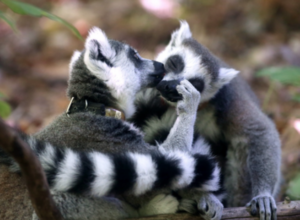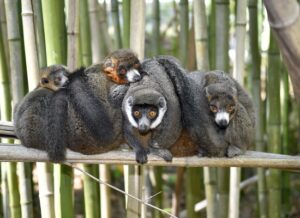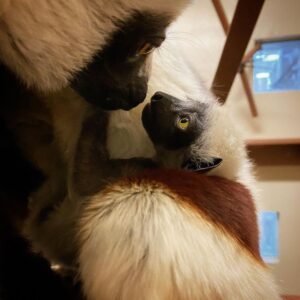The Science of Love: Oxytocin and Lemurs
Where does love come from? Feelings of love and care have often been associated with the heart, but when we look at love scientifically, it really all comes down to the brain. For years scientists have studied the chemical side of love and how it occurs in species all the way from mice to humans. In non-human animals, love is better described as bonding behavior, either between family members, social groups, or breeding partners. The main component of much of this bonding behavior starts in the brain as a hormone called oxytocin. Oxytocin plays a role in “love” behaviors like the bond between mothers and infants and in the creation of social memories. But just like the many forms of human love, the science of bonding behavior is, well, complicated!

Grooming is an important social behavior in lemur troops.
One question that becomes important when studying how bonding behavior works is what kinds of bonds animals tend to form. Across the animal kingdom, social structures and breeding behaviors vary widely, and even within closely related groups like lemurs, “love” takes many forms. Within the lemur family, most species are non-monogamous, meaning that they have multiple breeding partners during their life or even during each breeding season. This is common for mammals—only 3% of mammal species are monogamous, in which breeding partners mate for life or for the majority of their lives. There are very few monogamous lemur species, but the fact that some closely-related species can have such different bonding behaviors is a question worth exploring!

This tightly snuggled troop of mongoose lemurs includes (left to right) son Nacho, dad Duggan, mom Maddie, and daughter Bonita.
In order to try to answer this question, researchers at the Duke Lemur Center wanted to look at how oxytocin factored into these different bonding styles. Oxytocin is a hormone that can send signals between parts of the brain or sometimes to the rest of the body. It is most important during birth and nursing, as it sends signals to the brain to help both of these processes occur. However, oxytocin is also produced in the body during other bonding behaviors like cuddling. In order to see how the levels of oxytocin in the body might be different between monogamous and non-monogamous lemur species, researchers looked at both their brains and their behaviors.

Strong bonds are especially important for primates like lemurs, who need to learn many skills from their parents in order to survive into adulthood.
All research at the DLC is non-invasive, so none of this research caused any harm to the lemurs. The research team was able to look at the brains of lemurs that had died of natural causes long ago at the DLC, and see how the oxytocin receptors in monogamous lemurs differed from those in non-monogamous lemurs. Using a process called autoradiography, the researchers were able to create a map of places where oxytocin would bond to “docking sites” or receptors in the brain. They looked at the number and location of these receptors to see if monogamous lemurs had more areas of the brain where oxytocin would bond. While there were differences in oxytocin receptors between monogamous and non-monogamous species, the differences weren’t clear enough to determine whether oxytocin is the source of these distinctions in bonding behavior.
There are a number of reasons why different animals have evolved different bonding behaviors, including resource availability, predator defense, and genetic diversity. Studying how and why different animals “love” is a fascinating science, and one that affects every aspect of life on our planet. So, the next time you see a mother with a baby, pass a couple holding hands, or enjoy a big hug from a loved one, take a moment to thank oxytocin for being part of the equation, even if our relationship with this little hormone is a bit complicated!
Sources:
Grebe, N.M., Sharma, A., Freeman, S.M. et al. Neural correlates of mating system diversity: oxytocin and vasopressin receptor distributions in monogamous and non-monogamous Eulemur. Sci Rep 11, 3746 (2021). https://doi.org/10.1038/s41598-021-83342-6
Feldman, Ruth, and Marian J. Bakermans-Kranenburg. “Oxytocin: a parenting hormone.” Current Opinion in Psychology 15 (2017): 13-18.
Magon, Navneet, and Sanjay Kalra. “The orgasmic history of oxytocin: Love, lust, and labor.” Indian journal of endocrinology and metabolism 15.Suppl3 (2011): S156.
Kendrick, Keith M. “Oxytocin, motherhood and bonding.” Experimental physiology 85.s1 (2000): 111s-124s.
https://lemur.duke.edu/lemurs-show-theres-no-single-formula-for-lasting-love/

